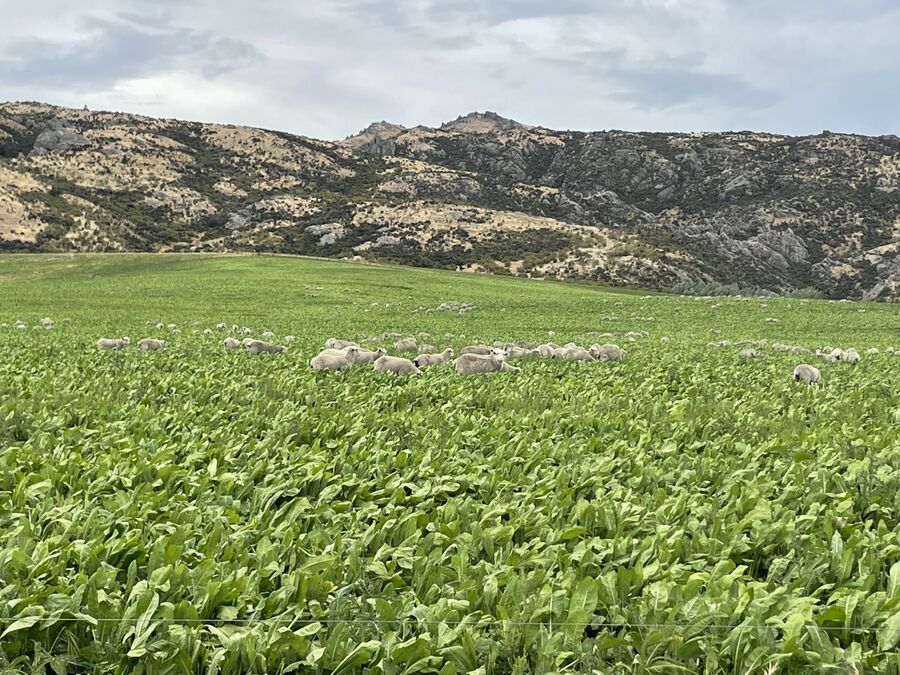
Summer feed shortages creep up fast. When pasture growth slows, having the right crop in the ground can be the difference between stock humming along or hitting a wall. Each option comes with its own strengths and catches, so the trick is matching the right crop to the right paddock.
Rape
Rape is one of the simplest options. It’s cheap to establish, carries a large bulk of feed into summer, and can regrow well if rain arrives at the right time. Stock perform strongly on it, and it also provides a handy opportunity for thistle and weed control. The main drawback is timing - rape needs 70–90 days to ripen before it can be grazed, low summer rainfall can impact regrowth potential. Once stock are transitioned, they should remain on it until lambs are prime.
Raphnobrassica
Raphnobrassica offers more flexibility. Unlike rape, it doesn’t need to ripen, so you can bring stock in earlier if pasture growth slows. It is drought hardy, with 38% greater water-use efficiency, and its clubroot tolerance makes it a reliable option under disease pressure. It also has strong potential to roll into winter feed if required. The seed is more expensive relative to rape.
Leafy Turnips
Leafy turnips are the fast movers. They establish quickly and can be grazed within 55–70 days, offering excellent liveweight gains. There’s no risk of rape scald, and they provide another chance to get on top of weeds. Leafy turnip has great regrowth potential provided it receives irrigation or summer rain, it can be susceptible to mosaic virus and leaf miner damage.
Clover Finishing Swards
Clover finishing swards deliver top quality and animal performance, with five to six grazings possible across the season and ME values in the 13–14 range. They give flexibility in how you graze - either intensively or under laxer systems - and with good management can last two to four years. Red clover does most of the heavy lifting in summer dry thanks to its taproot, while white clover provides a solid base. Including herbs like chicory and plantain can boost mineral content and tannins, with chicory improving carcass fatty acid profiles and plantain helping reduce nitrate levels in urine. On the flip side, seed costs are higher, thistle control is trickier when herbs are included, and yields can slip back in dry conditions. Red clover crowns also sit above the soil, making them vulnerable to overgrazing.
Kale
Kale is the longer-term option, with a grazing window of 100–200 days. Once it’s in, it provides a large bulk of feed that can either carry stock through summer or roll into the winter budget. It’s cheap to establish, can be used for flushing ewes, and also offers a weed control opportunity. Where it can fall short is utilisation - lambs don’t graze it as effectively later in the season, and the dense canopy can shade thistles, making them harder to manage.
Lucerne
Lucerne is a strong performer on lighter soils. Its deep taproot makes it highly drought tolerant, stands can last five to eight years with good management, and quality feed is consistent. It fixes nitrogen and can also be cut for supplements in spring. But lucerne has its sensitivities: it doesn’t tolerate wet feet or set stocking, it goes dormant through winter, and it requires annual winter spraying to stay clean. Despite best efforts, red gut losses can still occur and are an ongoing risk.
The Wrap-Up
No single crop solves every problem. Rape and raphnobrassica bring bulk, leafy turnip offers speed, clover swards and lucerne deliver quality and longevity, and kale gives you winter flexibility. Choosing the right option always comes back to your paddocks, your system, and the summer risk you’re trying to manage.
If you want to line up the best fit for your farm, give us a shout. We’ll walk the paddocks with you, weigh up the options, and make sure your summer feed plan stacks up.